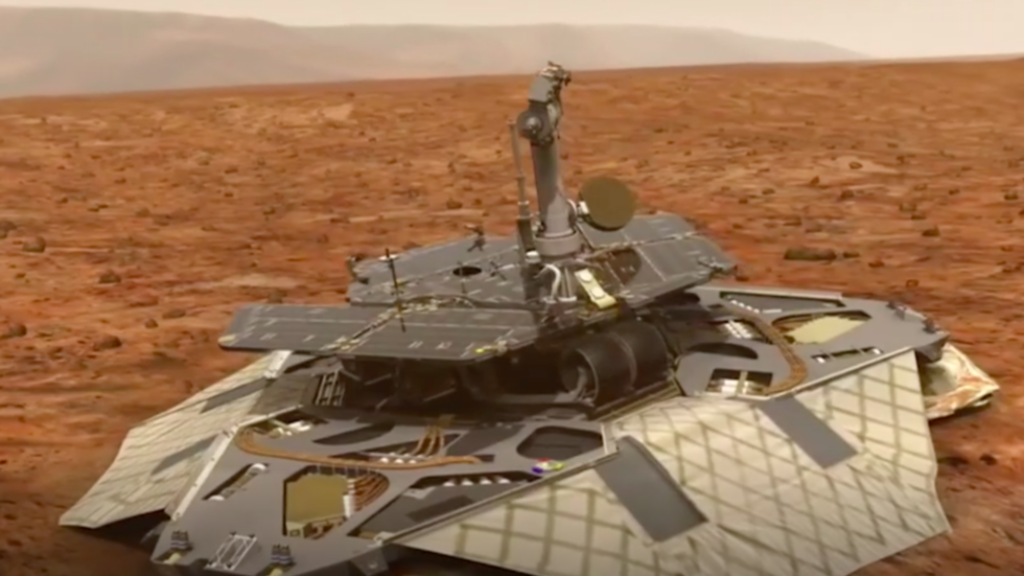Mars Passes Gas
Some mysteries on the fourth rock from the Sun.

Earlier this month, one of our probes on Mars detected a release of methane gas, which could be evidence of life of some kind below the surface:
Mars gave a good burp last week, but the gas has come and gone, leaving scientists no closer to knowing whether there is life on or beneath the red planet.
Last Wednesday, scientists grew excited when NASA’s Mars Curiosity rover, while testing the air of Gale Crater, detected high levels of methane, which on Earth can be produced by microbes or other living things.
Curiosity’s keepers at the Jet Propulsion Laboratory, in Pasadena, canceled the rover’s weekend plans to repeat the experiment, hoping for clues that might point to the existence of life on the planet. But the second reading indicated that the methane had fallen to its normal level in the Martian air — less than one part per billion, all but nonexistent.
Only a few days earlier, the methane level had spiked to 21 parts per billion, according to the rover’s Sample Analysis at Mars experiment.
“A plume came and a plume went,” Paul Mahaffy, of NASA’s Goddard Space Flight Center, said on Sunday during a presentation at an astrobiology meeting in Bellevue, Wash.
“The methane mystery continues,” Ashwin R. Vasavada, a mission project scientist, said in a statement from the Jet Propulsion Laboratory, where Curiosity was built. “We’re more motivated than ever to keep measuring and put our brains together to figure out how methane behaves in the Martian atmosphere.”
Methane, better known as natural gas, can be produced by microbes, including those that live in the guts of cows, or by purely geological processes. On Mars, sunlight and other chemical reactions should quickly destroy the molecule.
The fleet of robots orbiting and roving Mars has been on the lookout for methane, the breath of a possible something. And every once in a while, the planet has complied by emitting a puff of methane.
Scientists don’t know for sure where the gas is coming from or what is producing it. The first indications that methane was present in the Martian atmosphere came from telescopes on Earth and from Mars Express, a European Space Agency satellite launched in 2003. In 2013 both Curiosity and Mars Express registered a spike in methane up to 7 parts per billion that lasted at least two months.
But a more recent satellite, the European Trace Gas Orbiter, which arrived at Mars in 2016, has not reported any methane. And Mars Express, which passed over Gale Crater the same day as Curiosity saw its recent spike, has not yet reported its own results from that day.
Scientists working on the two European orbiters are still analyzing recent measurements.
Perhaps its just Martians who went for a Taco Bell run.
The methane discovery came around the same time that Curiosity took an odd picture that is leaving scientists baffled:
The more time we spend driving robots around Mars, the more strange things we’re likely to see. Not the scientific type of strange, such as the massive amounts of methane just found on Mars, but the good, old fashioned “weird light in the distance” type of strange that’s been confounding UFO enthusiasts down here on Earth since the invention of the camera. Well, we’ve got cameras on other planets now, and with it comes unexplained mysterious lights in the distance.
NASA’s Curiosity rover snapped a photograph of the Martian landscape on June 16 that shows a bright white light off in the distance, against the brown sand of the martian dunes. The photograph was taken by one of Curiosity’s “navcams,” two independent black-and-white cameras which act as the rover’s eyes and can take 3D panoramic shots, which NASA scientists use to map the Martian terrain. This photograph was only taken by one of the navcams, as the other was swiveled towards the rover itself at the time, taking what the Independentcalls“some kind of space selfie.” With only half of the navcams snapping the photo, it’s impossible to tell if the strange white light is actually coming from the surface of mars, or if it’s some kind of lens flare or other boring thing.
The light also appeared in only one photo. The photos taken immediately before and immediately after don’t have any trace of it, meaning that whatever it was, it appeared only briefly.
The light itself has a shape that does resemble a classic flying saucer UFO, which is surely proof of one thing: NASA’s entire public relations department must have one monster of a karmic debt they need to pay off. But obviously, and much to the chagrin of these poor scientists, NASA needed to address it, because not doing so would be proof of a cover-up.
NASA and the JPL will no doubt tell us this is nothing to get excited about, but we all know the truth






Cosmic flatulence.
That flash of light was a Martian teenager lighting his farts.
As opposed to Uranus?
Do the aliens have an inexplicable technological blind spot that means they’ve never discovered how to become invisible, like the F-35? Sad!
Or maybe they WANT us to see them … like we enjoy watching cats chasing a laser pointer.
@Ken_L: I’ve always suggested using the laser pointer as a cat IQ test. Some of the cats I’ve seen chasing it are obviously falling in love with the game, know full well that the dot is not real, and will happily play until at some point they’ll suddenly get bored, stop paying attention, lick their paw, yawn, and then walk away.
Other cats never do seem to figure it out….